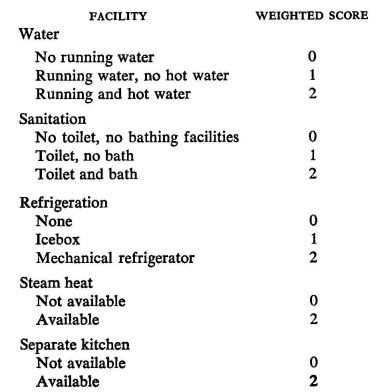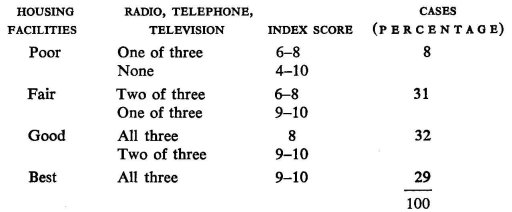APPENDIX I Some of the Indexes
| Books - Narcotics Delinquency & Social Policy |
Drug Abuse
APPENDIX I Some of the Indexes
Index of Family Cohesion
The family-cohesion index was constructed from answers to seven questions concerning practices of the family group in which the boy lived longest in the period between the age of ten and his critical age. Each answer was given a score of zero, 1, or 2—the higher score indicating a higher frequency or intensity of the given practice. These are the questions and scored answers:
1. How were Christmas, Thanksgiving, and other holidays celebrated?
Celebrated elaborately 2
Celebrated routinely 1
Not celebrated 0
2. How did you celebrate birthdays? (If Catholic, also saints' days)
Celebrated elaborately 2
Celebrated routinely 1
Not celebrated 0
Criteria for the distinction of "elaborate" and "routine" celebration were as follows: "elaborate" celebration means that, aside from the usual activities common in our society, there was a feeling of festivity, anticipation, and excitement in the family; "routine" refers to a perfunctory observance of the customs of the holiday. The interviewers were asked to probe for a description of a typical holiday or birthday and took verbatim notes on the boys' responses.
3. How often did your family have dinner together?
Always or usually 2
2-3 times a week 1
Rarely or never 0
If the answer was "always or usually," the question was asked:
4. Did the family break up immediately after dinner, or did it stay together for a while afterward?
Always or usually stayed together 2
Occasionally stayed together 1
Rarely or never 0
5. Did your family ever go out together—visiting, on picnics, and so on?
Frequently (more than once a month) 2
Occasionally 1
Rarely or never 0
6. When one of the family was sick in bed with a fever, how did the rest of the family act toward him? Did they try to be considerate of his feelings? Did they fuss about him, if that was what he liked, and leave him alone, if he wanted to be alone, or did they just disregard him? Or did they get annoyed even though they tried to be helpful? Or were they just plain mean? How did they act?
Very considerate or helpful but annoyed 2
Indifferent 1
Mean 0
7. In most families, there is some quarreling and fighting between parents and children, among brothers and sisters, or constituted parents. How often were there quarrels and arguments in your family? I don't mean kid stuff, but more-or-less serious arguments.
Frequently (once a week or more) 0
Occasionally 1
Rarely or never 2
The sum of the scores which each subject received on each item consfituted the index score; the higher the score, the more cohesive the family as measured by this index. Twenty-eight per cent of all cases had an index score of 7 or less (4 to 7) and were classed as "low" on family cohesion; 37 per cent received scores of 8 to 10 (classed "medium"), and 35 per cent scored 11 to 14 ("high").
Index of Family Mobility
The number and type of changes of the family residence to the time of the boy's critical age were recorded. Each type of move was assigned a numerical value of 1 to 5, depending on how drastic the move could be considered in the sense of entailing a more-or-less radical shift of the social scene. Thus, a move between rural area and big city was given a score of 5, and a move within one community, from one section to another, a score of 1. The mobility index consists of the highest score assigned to any of the recorded moves; its range is thus from zero to 5.

Indexes of Socioeconomic Status
Index 1: Source of family income. The question was: "Was your family usually self-supporting, or did they generally have to go to friends, relatives, or social agencies for financial help?" In cases in which the family did not have consistent means of income, the source which was used for the longest period of time was considered "usual." In the great majority of cases, the "usual" source of income could be determined without difficulty from social work or probation records. Eighty per cent of all subjects were self-supporting.
Index 2: Breadwinner. The identification was made on the basis of answers to the question: "Which person in the household contributed the greatest share of the family income?" In cases where two persons contributed an equal share or where no member of the household contributed at all, occupational data (for Index 3) were coded concerning the person who ranked highest in the following order: father, stepfather, or foster father; oldest male; mother, stepmother, or foster mother; oldest female. In 74 per cent of all cases, the father was the breadwinner.
Index 3: Occupation of breadwinner. After ascertaining the identity of the breadwinner, the question was asked: "What does [breadwinner] normally do for a living?" Both the type of work and the industry were ascertained. The classification of occupations was as follows for the 140 subjects on whom information was complete:

Index of Housing Facilities
The index of housing facilities was constructed on the basis of information on the number and kind of facilities in the boys' homes, including such essential facilities as sanitation and heating and such "luxury" facilities as radio, television, and telephone. To each of the "essential" facilities, a weighted score was given as follows:

The sum of scores for each facility is the index score for each case, giving a possible range in scores from zero to 10. The actual range of index scores was from 4 to 10. In addition, each case was classified as having "all three" luxury facilities (radio, television, telephone), "two of the three," "one of the three," or "none." The final categories of "best," "good," "fair," and "poor" housing facilities combined these two classifications as follows:
| < Prev | Next > |
|---|












